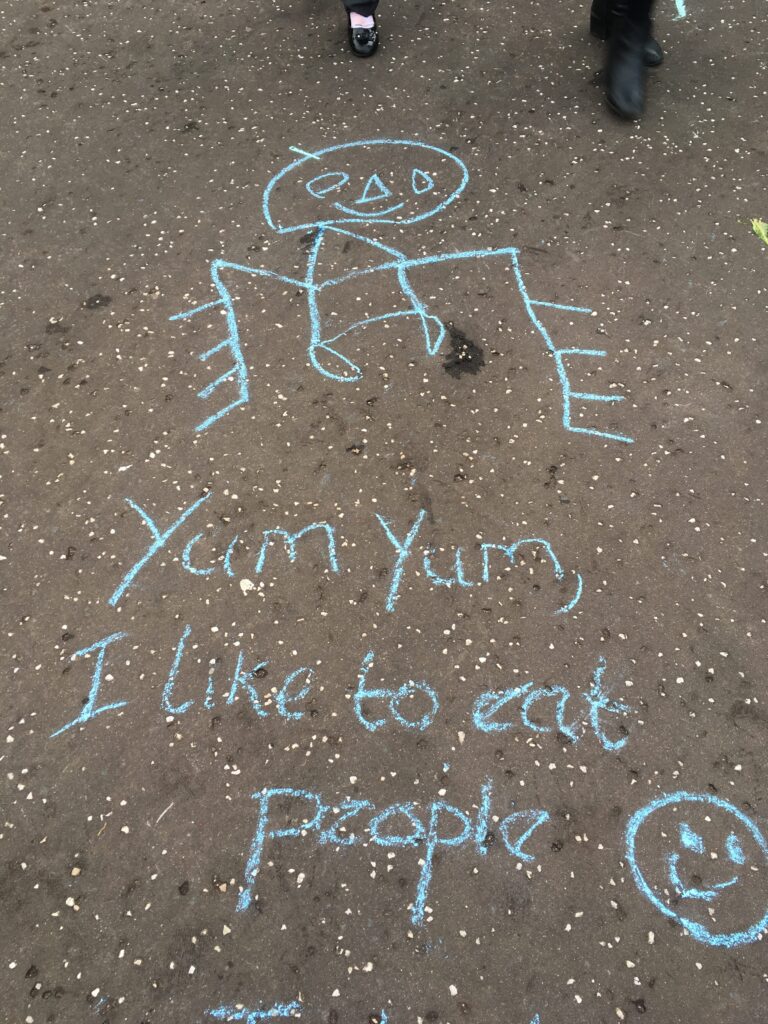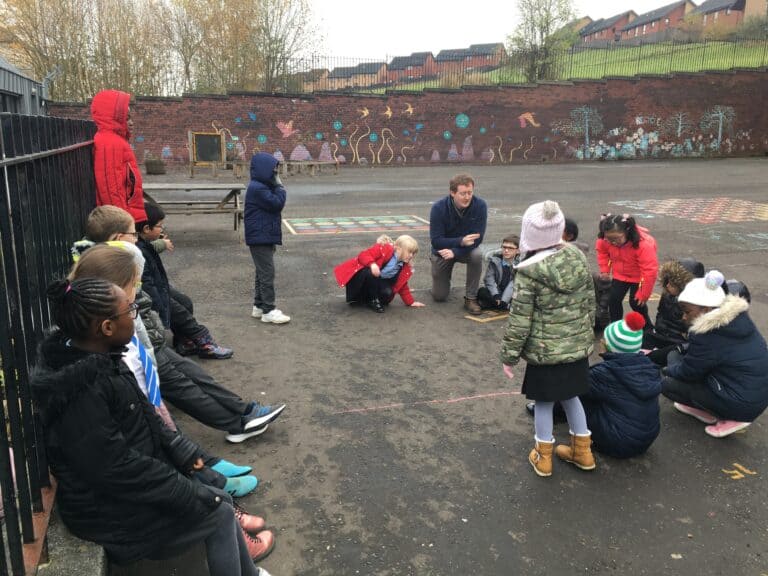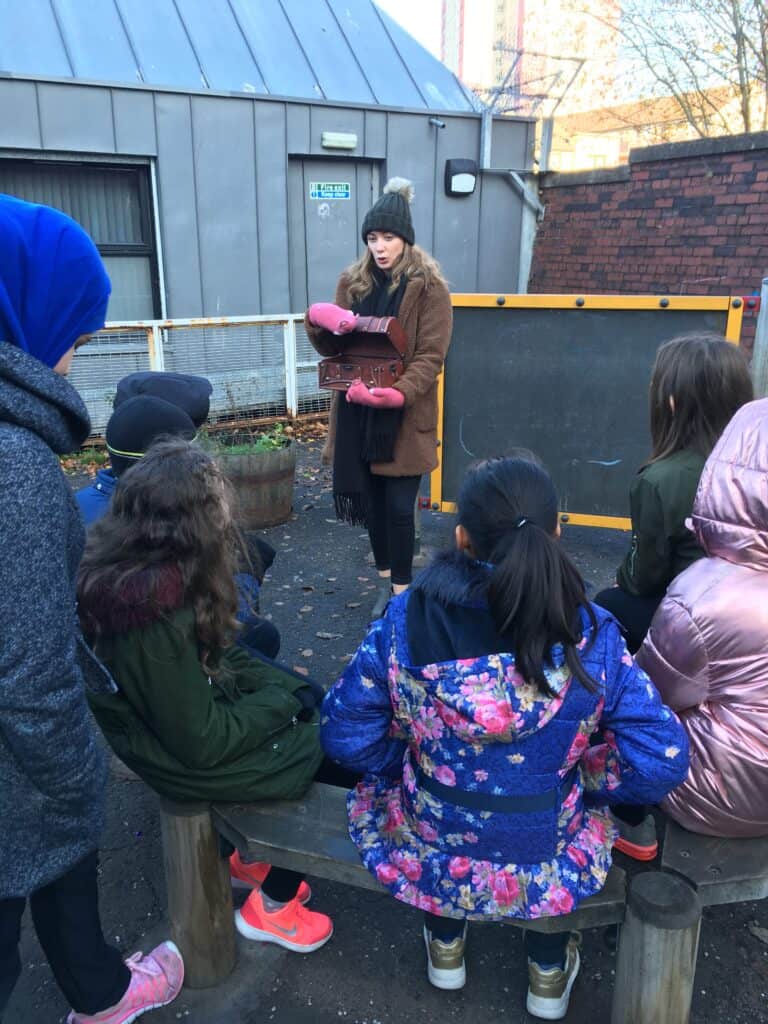Sarah Rankin, 09/12/2020
The sentiment ‘every day’s a school day’ has never rang more true than in my time spent with Royston primary. The project, the teachers, the pupils and my approach evolved and developed greatly over the five weeks of Out to Play. The project changed to respond to the participants and therefore engaged them to build confidence, work together and stretch their imaginations. The teachers committed themselves to the aims of Out to Play and used their expertise to deliver their own wonderful outdoor workshops. Personally, I learned a great deal about engaging children and young people who were originally reluctant to participate. Overall I was honoured to go on a journey with the school that built trust and confidence, all the while having a very fun and creative time. In this post I will reflect on how we designed the project to respond to Royston Primary’s playground and also their pupils. I will finish with a much needed expression of admiration for all of the teachers and staff at the school.
Royston Primary was a brand new challenge and thus needed a brand new approach. The school is situated in the heart of the city in amongst a very urban area. The school has a front and back concrete playground which they have made use of to its full potential. They have herb gardens, raised planters and even a grassy area growing beautiful trees. They have chalk boards and benches for outdoor learning and colourful murals painted on the walls. The school also have access to spaces they affectionately call The Garden of Eden and The Back Lands. The Garden of Eden has grass, plants, fruit trees and herbs that excite all your senses. The Back Lands are a ten-minute walk away and Royston primary take the initiative to visit regularly. Supported by a dedicated member of staff and a green fingered gardener, the pupils benefit greatly from the opportunity to connect with nature. As this wonderful example of outdoor learning was already in place I decided to focus the delivery of the Out to Play project on the other areas: the front and back playground and The Garden of Eden.
Each residency responds to the setting and the people we are working with and Royston needed very specific approach in order to make the most of their concrete jungle. Workshops we deliver in schools with access to more grass and trees would not work in this space. Therefore when designing the workshops I had to keep the playground’s layout and assets at the forefront of my mind. In the first week, we explored the story of The Giants Causeway and imagined the giants, Benandonner and Finn McCool, digging up the concrete in the playground and throwing it around Scotland. Funnily enough, at the same time as some of the workshops there was very loud construction works going on. We listened to this and imagined it was the Giants roaring and stomping and making the earth move. There would have been no point in trying to ignore the sounds of the city or the vast amount of concrete space. Instead, it’s best to make the most of it and incorporate it into the learning.
Three top tips on making a concrete playground magic
1. Enjoy the Space
Often concrete playgrounds offer a large space for activities. I have found this lends itself very well to games and in particular Drama exercises. Being outdoors in a large space means groups have more freedom to devise. Some of the teachers commented that when they do Drama in their classroom or gym hall there’s not enough space and it gets too loud. By using their outdoor playground the noise is able to escape and groups have the space to move around. The P7 teacher, Miss Johnstone, came up with the idea for groups to use chalk to draw out their setting on the ground. They then acted out their scene on top of their art work and even added to it throughout to show scene changes. This worked amazingly well and truly made the most of the concrete playground.
2. Outdoor Storytelling
Choose a story and make it as interactive as possible. The space in a playground allows you to travel through the story actively. You can explore in character and journey from one part of the story to the next. Outdoors, you can be as expressive as you like roaring like lions or spreading your wings like an eagle. Choose a story that fits in with your surroundings, like The Giants Causeway as mentioned above. Let imaginations run loose and you might be surprised with what the group comes up with. For example, after telling the story of The Giant Causeway I asked the class to go find clues of Giants in the area. They came up with fantastically wild ideas like a pot hole was a footprint, the school was a giant bed, the surrounding houses were giant chairs and the church clock was a giant alarm clock.
3. Treasure Hunt!
Large concrete spaces often don’t have many places to hide things. However, instead of hiding the treasure where they can easily find it, you can set challenges that they have to achieve to earn the treasure. For example, I used the front playground as the challenge area and the treasure chest was actually in the Garden of Eden. Challenges included collecting 5 different looking stones / leaves / sticks. Finding three different smells / textures / colours. Creating a secret handshake and giving compliments. Once we shared some of our findings, we collectively decided we had passed the challenge and were granted access to the treasure chest. The chest was full of bird seeds and as some of the pupils noted ‘It’s a gift for nature, not us’.



The workshops not only had to respond to the space but also the people. My first hurdle was to break down barriers to engagement and encourage the classes to get on board. My biggest challenge was to win over the too cool for school P7’s, understandably distracted by the struggle of growing up and the woes of peer relationships. Therefore, instead of hurdling in full throttle in a cape and with a treasure chest full of fairy dust (like I have in the past) I needed to take the time to build trust. Especially with the upper primary who were understandably sceptical of the veracity of magic in their playground.
I am very proud to say that by the last week I had managed to build relationships with individuals who did not engage in the beginning of the project. This was down to a joint effort on my part and the teachers. Most of all, it was a journey the classes went on together to figure out what they wanted from the workshops. Some wanted to play games, some wanted to do as much drama and storytelling as possible and some wanted to listen to as many stories as possible. As the facilitator or teacher you have to find a balance between their wants and needs and also your own objectives. It takes time to get to know these multifaceted children and young people and it’s time very well spent.
Three top tips on engaging children and young people
1. Don’t force it
As a facilitator working with a new group I always give them the option to opt out. For example, if you are doing a name game in a circle and someone doesn’t want to say their name then you can easily skip them. You can offer to come back to them later, they can whisper it or ask them if they want a friend to say their name for them. You can encourage but putting pressure on them in front of their peers isn’t going to make them want to participate. When meeting a new group your priority is to build trust and confidence. A way to avoid this is to ask the group who wants to start. This way you begin with an individual who is enthusiastically taking part and this will encourage others to follow. There’s nothing worse than one person saying no and having a domino effect of no’s follow.
2. Make it relatable
Make the story age and stage appropriate. Younger groups enjoy stories with animals and they can contribute easily with their favourite ones. Older groups prefer more ‘mature’ stories with people and characters they can relate to. I’ve found Greek Myths work well with the upper primary. What better way to get young people to connect with a theme than to use the dramatic exploits of the Greek Gods. For example, Persephone and the Pomegranate has it all. A smart and beautiful young woman who breaks the rules (picking a Narcissus), angry parents, petrifying god of the underworld, flying messengers and even a three headed dog. This story helped me get the P7’s full attention You could hear a pin drop. The best response was ‘Wow, that’s how we have the seasons’. Though my aim wasn’t to to completely confuse the class on why the seasons change, I was happy to know that the story had resonated so deeply. And that the P7’s were able to, even if only for 10 minutes, believe in childhood magic.
3. ‘Yay we don’t have to do work!’
Another way to encourage hard to engage groups is to use lots of fun games. Some of the classes got on board with the project because they didn’t see it as work. Little did they know that through listening to stories, playing drama games, and making their own stories they were improving their literacy, confidence, health and wellbeing, team work, listening, vocabulary and much more.
Admittedly, in the beginning, there was some hesitation from the teachers. There was the usual reluctance to go outside as the winter weather fully set in. But there was also a worry that the pupils would not be invested in the workshops. Delivering workshops with magic treasure chests and immersive stories in which pupils would have to do silly voices and dances did not seem achievable. Not because we didn’t believe the pupils capable but because confidence was low and some pupils didn’t have much experience of drama and storytelling.
However, over the five weeks we worked together to get the children and young people on board. I truly feel they became invested in their Out to Play journey. Teachers and classes embraced the opportunity and have started their own outdoor adventures. Already Miss Bonner in P1 was struck with inspiration during a lesson and spontaneously decided to take them outdoors. Miss Johnstone (P7) said she would adopt the Out to Play approach and wouldn’t teach her lesson on Pandora’s box any other way as her workshop went so well.
The teachers were unbelievably creative, enthusiastic and supportive throughout the project but especially during their teacher led week. They put a lot of effort in and used their natural storytelling and dramatic skills. Their workshops closely followed the Out to Play structure (Wonder – Excitement – Inspiration – Collaboration – Sharing – Reflection) and they reflected that this worked very well. I learned a lot from their approaches and I’m definitely borrowing a few of their activities (for example chalking out settings on the ground.)
Thank you so much to all of the teachers, staff and pupils as Royston Primary for a wonderful 5 weeks. It is a very special school with endless energy and passion and I look forward to seeing what they get up to in the future.








![glasgow city council logo [black] Glasgow City Council logo](https://ecodrama.co.uk/wp-content/uploads/2023/12/glasgow-city-council-logo-black.png)
